Choosing the best fabric paint for your next craft project just got easier. Of all of the different fabric paints on the market, we have selected the best paints and paired them with a guide to fabric paint to help you choose the right option for your next craft project.
If you are interested in fabric painting it is an excellent and affordable way to transfer awesome designs onto fabric. Fabric paint can be applied to virtually any fabric type including synthetics. Other methods of transferring artistic designs onto fabric like heat transfers and sublimation are less accessible and costs are substantially more.
This is also a fantastic activity for kids and groups to participate in. A little fabric paint can go a long way and requires very few supplies to get started. Beginners and seasoned artists alike can create wonderful personalized crafts together without having to cater to individual skills individually.
When children get to create their own designs and then wear them, nothing can be more gratifying. Just as well, seeing a family or friend wear your creations is just as great. Check out the guide below to get started with fabric painting crafts.
Complete Guide To Fabric Paint: How To Choose Your Paint
Fortunately, when searching for fabric paint which is also referred to as textile paint, you don’t have to worry too much about the type of paint you choose. Usually, it is more important to pick a paint that is in a form that is compatible with how you intend on laying down the paint.
Since there are many ways to paint fabric, including brush painting, spraying it, as well as paint markers, you should choose the paint that will work best for the method of application. Lastly, dye is another method that can technically be used for coloring fabric using paint techniques but it is less popular.
Textile paint can also be used on a variety of other mediums like leather, wood, and synthetics materials just as well.
Once you understand the different types of fabric paints and how they can be applied to fabrics you will be able to select the right fabric paint for any project and fabric you have in mind.
Types of Fabric Paints
What is textile paint? Textile paint or Fabric paint typically consists of color pigment that is then emulsified with a binder that can be delivered to paint medium, which for this purpose is fabric. This media can then be delivered to the medium to create artistic designs.
If you are wondering what is the difference between textile/fabric paint and fabric dye, it is quite simple. Fabric dye aims to bond the pigment molecules directly with the fiber molecules of fabric. The problem with this is different fabric types require different dye types, which you can read more about in our fabric dye guide.
Fabric paint only aims to affix or bond the paint to the fabric which eliminates the issue of worrying about what fabric type you are working with. Each will ultimately achieve a different look and effect.
Acrylic Based Fabric Paint
Acrylic based fabric paint is the most common and popular form of fabric paint and will achieve the best results in most cases. Color pigment is added to the acrylic polymer and then emulsified with water to create the fabric paint.
Acrylic paint is typically able to form the best bond with fabric and is also the most durable, holding up under repeated washing and resisting fading from light exposure. The other benefit is the ability to change the flow or viscosity of fabric paint without diminishing the color saturation. Conversely, you can also change the transparency without changing the consistency.
In most cases, acrylic fabric paint is the best choice for painting your garments or other textiles. Acrylic based textile paint can be brushed on, sprayed on, as well as in paint markers.
Alcohol Based Ink
Alcohol-based inks are less commonly used for fabric painting mostly due to a fabrics porous surface but you can still create beautiful designs. In this form, alcohol is used as a binder to deliver the pigment to the medium. Alcohol ink will achieve the best results on non-porous material as the pigment can bond directly onto the surface giving the best appearance.
If used on a porous surface, alcohol pigments will have a more transparent look and will not have the color saturation of acrylic. More application will be needed to achieve a rich color. It is also important to note that this form of fabric paint will not always achieve great results on darker fabrics. Lastly, alcohol based inks are not nearly as washfast unless you seal it with a fabric varnish of sorts.
Fabric Dye
Fabric dyes can also be used as paints but the results will often be different than fabric paint. Sometimes the appearance will be more like alcohol based inks than acrylic paints. The setup and process can also be much more involved than your typical fabric paints.
Fabric Paint Form & Application
Fabric paint and inks can be applied in a number of ways achieving a variety of effects. Some are more versatile while others can produce very unique designs and appearances.
Liquid Fabric Paint
Liquid paint is by far the most popular form of fabric paint and can be found in just about any craft store. It is readily available in many different consistencies and there are many additives available to change both transparency and consistency to better suit your needs.
Liquid textile paint is the most versatile form and is used for brushing, splattering, and even spraying via an airbrush system onto fabrics and textiles. Liquid textile paint is usually the go-to choice for most crafters. Liquid fabric paint is available in both acrylic and alcohol bases.
Fabric Markers
Fabric markers can be more limited in the artistic designs they can achieve compared to liquid paint but they certainly have their place. They are very convenient and portable. Paint markers are also a very great choice for kids since they do not require any special setup and cleanup is minimal.
If you are interested in learning more about fabric markers check out our Fabric Marker Buyer’s Guide.
Fabric Paint Spray
There a few options available to crafters that can be sprayed onto fabric. The cans are used just like regular spray paint but are specifically made to be applied to the fabric.
Dimensional Fabric Paint
Dimensional fabric paint is also known to some as puff paint is acrylic based paint the dries with a textured or raised appearance. This form of fabric paint is acrylic based and can create really interesting designs on fabric and other textiles.
Other Considerations to Selecting Fabric Paint
Fabric paints have a few other characteristics one should consider in addition to the paint type and application method. These are other attributes that will also affect both the final appearance and application of the paint.
Fabric Paint Opacity
A fabric paints opacity refers to how opaque or transparent a paint is when applied to the fabric. This can produce both desired effects as well as determine how well the color shows up on the fabric. For darker colored fabrics and material you will always need to go with a more opaque paint so the color is more visible and vibrant on top of the dark color.
Paints that are transparent or opaque will work well on lighter colors. Lighter colored fabrics typically aren’t affected by the opacity of paint but if you are painting a lighter paint color on a light fabric color it is better to use more opaque paint. There are also additives like Flowable Extender
Paint Body & Consistency
The body and consistency of paint will affect both the feel of the paint on the fabric once dried and the application of the paint. A thin or body-less paint will work well in an airbrush system or for someone who desires a more watercolor-like consistency when painting.
On the other end of the spectrum, heavy body paint is how paints are able to achieve textured or raised appearances when dried. That said you can achieve virtually any desired consistency using different additives, simply adding a little water can make the paint more flow.
Heat Setting fabric Paint
Most acrylic paints will have to be set with heat to make them permanently set into the fabric. If you are painting onto any heat sensitive fabrics be sure the heat setting requirements can be handled by the fabric. If you are not able to heat set the paint in may not adhere like it should and will not be as durable and long lasting. If you are using acrylic paints you can try using Jacquard’s Airset Product when heat setting isn’t an option.
Since you have a better understanding of what makes great fabric paint you can set out to find one that works best for your needs. We have also provided several choices of the best fabric paints so jump into the list now.
The Best Fabric Paint- Top 7 Quick Reviews
Below is a complete list of the best fabric paints available. We have included an option for every single type of paint which should provide unlimited possibilities when painting on fabric and other materials. From acrylic based paints to alcohol-based inks, you will find one on the list. If you are heading to your local craft store, the best fabric paint brands are going to be Jacquard, Tulip, and Liquitex.
JACQUARD DY-NA-FLOW FABRIC PAINT
Dy-Na-Flow fabric paint is a highly saturated bodiless acrylic paint by Jacquard. This form of acrylic being so thin is also transparent and the way it reacts with the porous and semi-porous fibers is very similar to that of a true fabric dye. These characteristics make it a great fabric paint for silk. For those in Europe Pebeo Setacolor Light Fabrics Paint is another great fabric paint much like Dy-Na-Flow.
While Dy-Na-Flow is incredibly saturated and produces vibrant colors to the transparent nature it will not perform as well on darker colors. For lighter colors, however, you will be amazed at the intense colors produced on fabric.
The feel of dried Dy-Na-Flow on t-shirts is very light and not very noticeable at all especially when compared to the heavier bodied paints. Another great attribute is how wash-fast and durable this line of paint is since it is able to penetrate the space between fibers more effectively than thicker paint. Finally, you can also run it through airbrush systems without issue, adding to the versatility of this line.
Key Features
- Bodiless Acrylic Base
- Transparent
- Can be used in Airbrush Systems
- Mixable with other Jacquard Textile lines
- Fabric: natural and synthetic fabrics, wood, paper, clay, canvas, suede, leather
JACQUARD TEXTILE COLOR PAINT
Often considered the standard for professionals, Jacquard’s textile is the best fabric paint due to its all-around-performance on a variety of substrates. This semi-opaque paint performs moderately well on darker colors and leaves the fabric soft to the touch.
The other great thing about Textile Color is the ability to both thin it with water to achieve more viscosity or add Color Extender to increase the color transparency without affecting viscosity. Additionally, you can intermix Textile Color with many other Jacquard paint lines making an endless option of colors and effects.
If you want a paint that is more versatile and not so specialized like the Dy-Na-Flow, Textile Color is a great option that performs well on virtually any surface. You can expect great paint designs that are washable, and very colorfast.
Key Features
- Semi-Opaque Medium Body Acrylic
- Semi-Opaque
- Inter-mixable
- Fabric: natural and synthetic fabrics, leather, wood, canvas, paper
JACQUARD NEOPAQUE FABRIC PAINT
For painting on dark fabrics, Jacquard’s Neopaque is one of the best fabric paints for the job. This highly pigmented paint is fully opaque giving it the ability of full coverage on the fabric without the dark fabric saturating through into the color.
The opaque qualities of the paint lend to it being a heavy bodied paint. At full strength, the fabric feel will be slightly heavier than the Dy-Na-flow and Textile Color but overall still soft. The paint can also be thinned with water somewhat to achieve a slightly lighter body if you desired so.
You would want to choose the Neopaque line if you are either painting on darker colors or desire the thicker texture and feel of a heavy bodied paint. For other projects, you may want to use a different line as some feel the lighter bodied paints are easier to work with.
Key Features
- Opaque Heavy Body Acrylic
- Perfect for dark Fabrics
- Highly Pigmented
- natural and synthetic fabrics, leather, wood, canvas, clay, vinyl, plastic, rubber, paper
TULIP DIMENSIONAL FABRIC PAINT
If you are planning a paint party for a bunch of people or having a children’s birthday, Tulips Dimensional Fabric paint is an excellent choice. Tulip’s line of paints is designed to lay the paint down directly from the bottle so you won’t need to worry about supplying a ton of paint brushes or needing to spend a ton of time on cleanup. The Tulip Party Pack Is also a great choice for those party as it comes with a variety of color options in a convenient package.
Tulip is the best option if you are looking for an inexpensive line of paint that is still durable and offers a great selection of colors. An all-around great paint for all ages as it is non-toxic and is also available in a variety of finishes a well. One great project idea is using it to add grip to the bottom of socks or gloves.
Key Features
- Acrylic paint
- Great for most fabrics
- Very affordable
JACQUARD LUMIERE FABRIC PAINT
If you are looking to add a bit of shine and sparkle to a piece of fabric, the Lumiere line Jacquard provides high-quality results with metallic or pearlescent effects. This semi-opaque light-body line of paints will transform your next project into a beautiful creation. One great thing about the Lumiere line is its ability to mix with Jacquard’s other lines to create custom colors and more transparency if you desire.
Lumiere is a very durable paint with outstanding adhesion and can be built upon darker fabrics to achieve a more opaque result that really stands out. They are especially useful for leather and the results very good. If you are looking for the metallic and pearlescent effects, Lumiere is the best choice of fabric paint on the market. The final note is the additional availability of Lumiere 3D which is the dimensional version of the Lumiere line.
Key Features
- Medium Body Acrylic
- Metallic and Pearlescent Effect
- Fabric: natural and synthetic fabrics, leather, wood, canvas, vinyl, plastic, rubber, clay, paper
JACQUARD PINATA ALCOHOL INK
For a different more translucent effect on fabric, alcohol-based inks are a great option and Pinata Ink is one of the best quality pigments out there. If you didn’t read the guide, alcohol-based inks usually attain a more dye like effect compared to true fabric paint. The other benefit of ink is the ability to apply it over acrylic paints to quickly and easily modify the color.
Another great option for working with alcohol-based inks is using them in airbrush systems. The high flow of inks will spray incredibly easy through an airbrush. This type of product works best on certain synthetic fabrics and other non-porous surfaces. Inks are very lightfast and vibrant and clean up with alcohol. Another benefit is the ability to blend colors into each other create remarkable effects. Keep in mind, alcohol-based inks should usually be considered when acrylic paints or fabric dyes are providing great results.
Key Features
- Great alternative to Acrylic Paint
- Metallic colors also available
- Surfaces: glass, metal, plastic, vinyl, ceramic, stone, leather, acrylic
CRAFTS 4 ALL 3D FABRIC PAINT
If you are looking for a great set of fabric paints but your budget is limited this is the set for you. With 24 colors in the paint set, you really can’t beat the value of these fabric paints. For anyone looking to provide a fun activity for kids to enjoy, you can’t lose with this set as it is both odorless and non-toxic.
As for the quality of such an inexpensive set, it is surprisingly durable and the set comes with a satisfaction guarantee. the only downside to the set is while you are getting 24 different colors in the set, the quantity of each color is somewhat small. Take care not to use excessive amounts and the should last for several projects.
Key Features
- Acrylic paint
- Great for most fabrics
- 24 colors og affordable and easy to use fabric paint
BONUS: LIQUITEX FABRIC MEDIUM
For those of you who already have a stock acrylic based paint not already formulated for fabric, Liquitex Fabric Medium is a wonderful option. While it is formulated for Liquitex branded paints, I have tested it with success on other brands as well. This fabric medium enhances the workability of acrylic paint on fabric when added. It creates a more lightweight and workable medium which makes existing acrylic paints more workable when applied to the fabric.
Another great benefit of the Liquitex Fabric medium is it does not need to be heat set. A great non-toxic additive to many of the Liquitex paint lines which instantly transforms them into fabric paint. You also test other acrylic paint you may already have to see if they may be compatible.
Key Features
- Dye Cotton, linen, silk, wool, ramie, rayon, nylon and more
- Over 500 additional color recipes available
- Simple dye process
We understand there are a ton of options out there and they can all be very similar or very different. If you are still left with questions, please leave us a comment and we will put you on the right track. Feel free to leave us your top picks as well, we may even add it to our list!

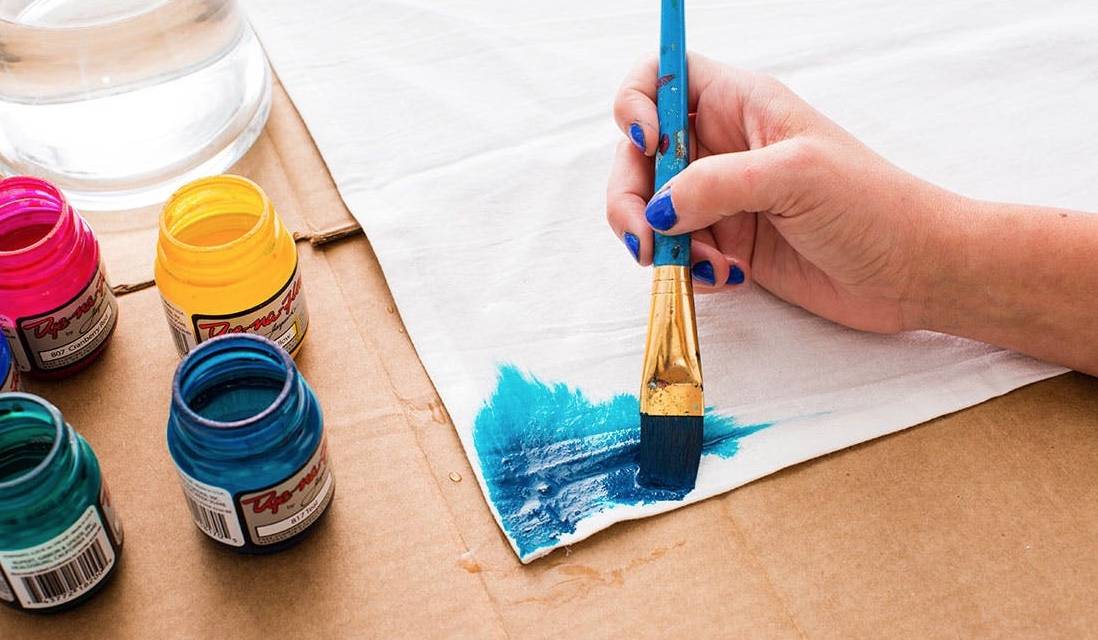
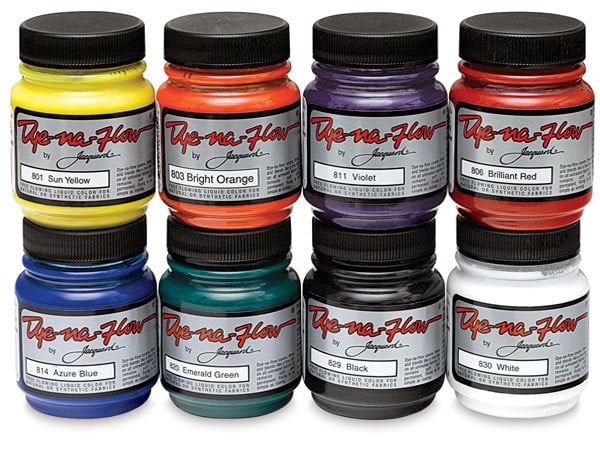
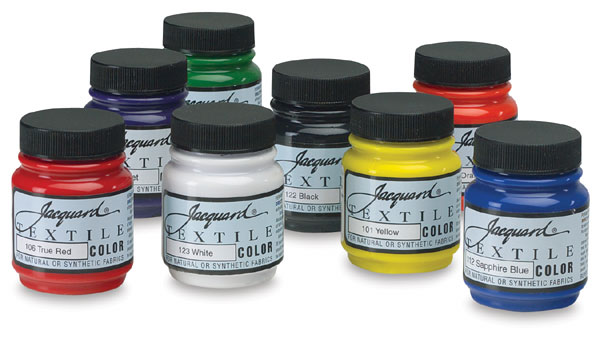
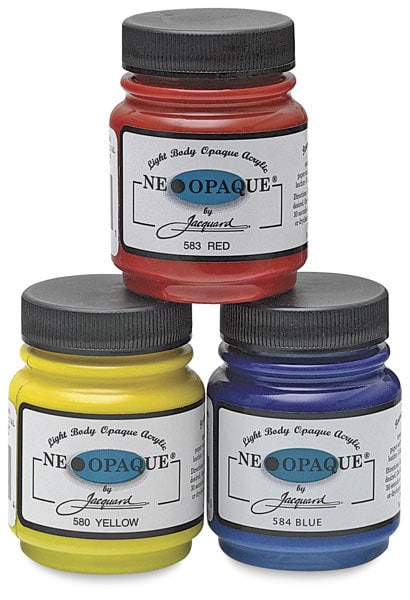

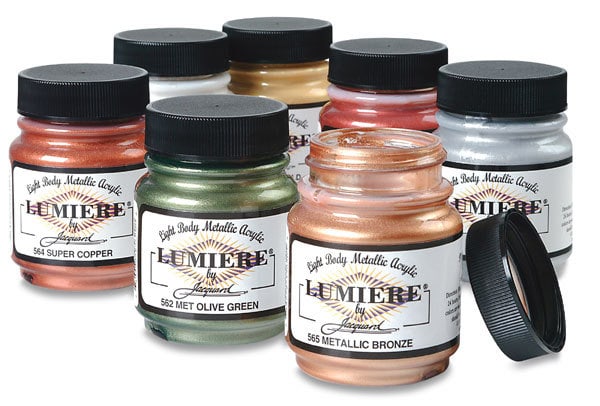


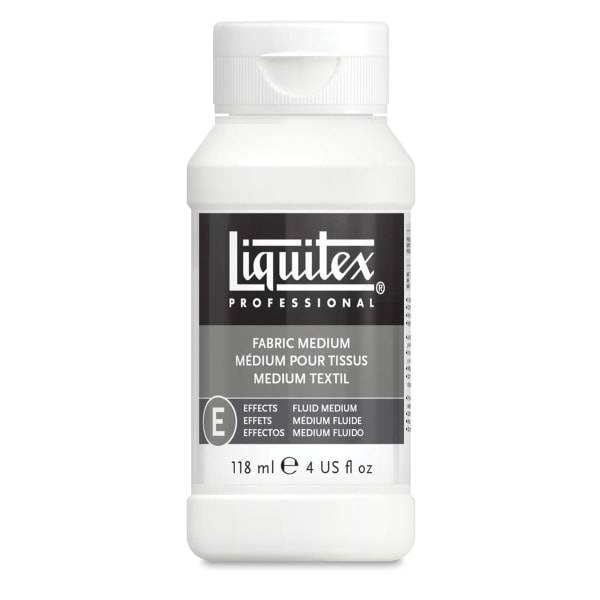










sorry, this is a query, not a reply.
what dye product or method would you advise for printing on fabric with wooden stamps?
thank you,
Judy
Hi Judy this is a great question! For stamping on fabric you can use either an pigment ink like Versacraft by Tsukineko which will produce great wash-fast results and is specifically made for stamping.
Another alternative is using a very high flow paint that is pigment rich. Jacquard’s Dy-Na-flow from the list above is a great option as well as Jacquard’s screen printing ink which can be rolled on with a foam brayer. Whatever you use just follow the manufacturer’s instructions and you should get great results. Also, be mindful if you will need to heat set the product you use.
Good luck!
What is the best paint for Tafetta?
Hi,
Which paint would you recommend for painting detail onto denim?
Thanks!
HI,
I am looking for a washable and durable fabric paint to use with a stencil. I will be painting t-shirts. What would you suggest? Thanks
Hi Marie,
Any of the paints listed aside from the Dy-Na-Flo and Pinata Ink should work just fine for stenciling as the two I list may bleed through the stencil a bit. Just be sure any paint you use has a little body which should keep it from bleeding under the stencil.
Good Luck!
What is the best type of paint and the best method to paint a small piece of fabric luggage?
Hi Sherry,
It really depends on what type of fabric you are painting and what type of design and look you would like to achieve.
Hi- Finding this is perfect timing for me. I have bought some fake flowers and greenery to make a table runner, but the theme is outer space and science fiction. I’m trying to find a paint I can use that is almost neon or fluorescent, but will show bright, not glow, in a little room. Trying to get lines or accents of acid yellows and greens and pinks, but everything I’m finding is too dull, or requires a black light.
I have a quilt cover that had a thin black felt design on it and now the felt has come off and I have a dark grey design left. What would be the best fabric paint to use to make it black again?
Great article: helpful! I was wondering if you mix the Liquitex (which doesn’t need heat to set) with acrylic paints that need to be heat set will ironing affect the Liquitex negatively? Thanks
This is a great question and personally have not encountered this scenario. My advice would be to test it on a test piece. The heat-set acrylic may not set without the heat even with the fabric medium.
Good luck!
What is the best fabric paint to use on polyester drawstring backpack
I am looking for a fabric paint that is safe for children to use to make a handprint on 100% cotton fabric for a quilt. What would you recommend?
Thank You.